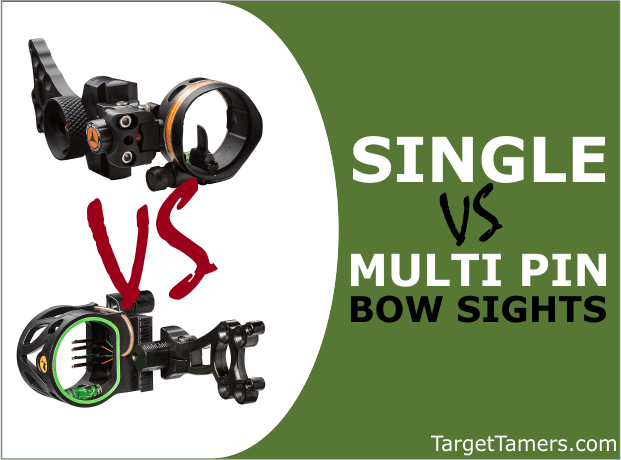
Every shooter will be partial to one type of bow sight for many a reason. A single pin might be what you feel comfortable with or you might prefer the convenience of fixed pins for moving targets.
Regardless of rock-solid opinions that one is better over the other, there are advantages and disadvantages to both designs.
Let's put them head to head to see how and where these bow sights shine in their own right.
What is a Single Pin Bow Sight?
As the name so clearly implies, a single pin sight has only one pin. These sights are also known as moveable, sliding, and adjustable pin bow sights.
The pin can be used and set for exacting distances out in the field. A sight tape with marked yardages is used with an indicator or pointer on a sliding scale so you can select what distance you want to set the pin for.
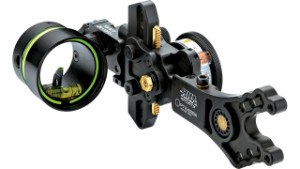
What is a Multi-Pin Bow Sight?
Multi-pin, fixed pins - same thing. Multiple pins in sets of 3, 5, and 7 are set in the sight housing and can only be used for fixed distances. You cannot adjust these pins for various distances while out in the field without special tools.
While sighting in a multi-pin sight, you will set each pin with a specific distance starting with the top pin having the closest distance. Each pin down will be set for a distance in either 5 or 10 yard increments. For example, a 3-pin sight may have a setup of 20, 30, and 40 yards.
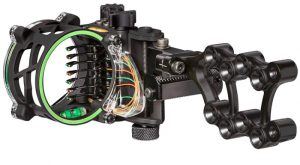
Single Pin Sights VS Multiple Pins
Which bow sight is better? We're not going to get caught up in the dust storm of this debate as personal preference, experience, and circumstances rule over other's opinions.
Instead, let's shine light on the bow sight that does it best for a particular need.
Accuracy
Properly sighted in and with practice, you can get make well-placed shots for both hunting and competition use with fixed pin sights. But, game doesn't graze in at even yardages that match your pin setup causing you to have to gap your shot, and gapping shots means there's a certain level of guesswork going on.
Single pin sights certainly reign superior when it comes to accuracy. The ability to use a sight tape and set the sight for a specific distance allows for as much precision in your shot as possible. By removing the guesswork on where your pin is aiming, you improve your chances of making a clean kill or hitting the bull's-eye. If a kill-shot is what you are after, check out our pick of the best bow sights for deer hunting, they will do the job nicely!
Winner: Single Pin
Quick Use on Moving Targets
While single pins have the upper hand of making precise yardage adjustments in the field, they do require you to adjust with every shot and often on the same target as it moves from one spot to another. Getting to a full draw and then having to readjust for the shot again when your target moves can make for a slower process while increasing the risks of being spotted due to the extra movement.
Multi-pins obviously have the advantage since you either have a pin already set for the target's distance or it's within your pin gapping ability. Instead of having to let down and readjust for the new distance, you simply pick the appropriate pin or particular point between the gap you need to use to make the shot.
Winner: Multi-pin
Close Range Guesswork
Bow sights are aids for shooters in achieving tighter groups, a higher precision of accuracy, improve target focus, and faster target acquisition. But, there's no denying that some level of guesswork will almost always be a part of your hunting or competition experience.
Single pins allow for extreme accuracy and reduce yardage guesswork especially when you have an advantage over game at longer distances. However, when a target moves towards you, you should be readjusting your sight again which we decided is a disadvantage, unless you know a few tricks. Understanding how to set your sight pin for a "fixed" position or using the Trick Pin method is a way around this. But, it does require understanding and knowing arrow trajectory for close encounters and a lot of practice to get it right.
A multi-pin sight allows you to gap the shot or use the appropriate pin for close encounters and approaching game without making any adjustments. At longer distances, pin gap will also increase (due to factors that include bow speed) and can be difficult to achieve accuracy. However, given the proximities that many shooters take most of their shots, fixed pin sights remain popular and hunters are accustomed to using this type of sight even if includes some guesswork.
Winner: Multi-pin
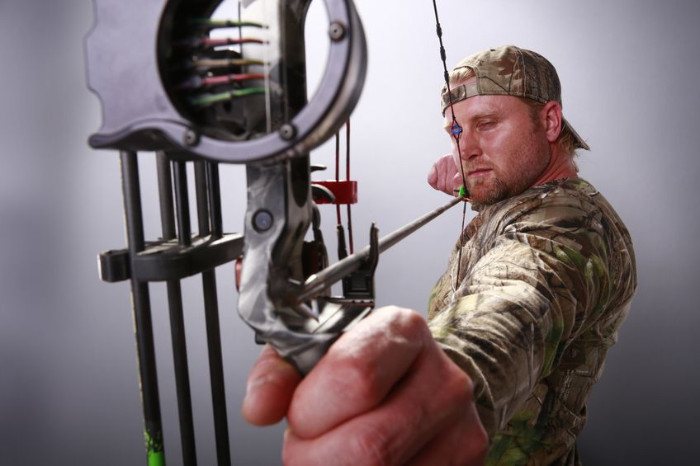
Stealth/Covertness
It's no secret that single pin sights require more movement than a fixed pin sight - it's the nature of its design. However, it's not as bad as many may choose to believe. Being deliberate out in the field can make a huge difference in how minimal movement can actually be.
But, it doesn't take away from the fact that multi-pin sights are designed for promoting limited and minimal movement. Of course, if you're trudging around like an elephant in the jungle or like a newbie on their first hunt, no type of bow sight will save your cover.
Winner: Multi-pin
For Beginners
The results for this category are subjective, so we'll give our reasons for why we say a single pin is best for beginners.
Multi-pins have consistently set the popularity trend in the market and part of the reason is for its simple and easy to use design. No adjustments in the field, just aim with the pin you need and shoot. However, practice with pin gapping will be required and the constant readjusting during sighting-in will provide much-needed practice for a beginner archer.
Single pin sights remove the guesswork on pin gap. This allows for an easy introduction into bow shooting for beginners. In the hunt, you don't have to try to choose the right pin either by position or color and then calculate how much to hold over or under in the heat of the moment.
It may take a little more movement to use a single pin in the hunt, but it may be easier for the newbie who's under a lot of pressure and pumping with adrenaline.
Winner: Single Pin
Clarity
It's a no-brainer, single pin sights win this race. The single pin clearly offers the most clarity and the largest, unobstructed field of view.
One of the major disadvantages of multi-pin sights is the cluttered field of view that can obstruct at least a third of your view and sometimes maybe even more. With stacked pins, you're also more at risk of choosing the wrong pin for a shot. You'll have to train your eye to focus on the right pin at the right time along with all the other variables and decisions you have to make in that moment. This is why a single pin bow sights heads this point.
Winner: Single Pin
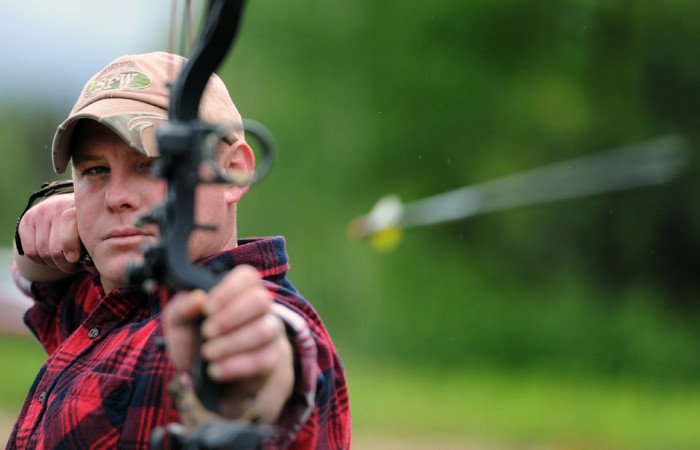
Activity-Specific Needs
Some bow shooting activities may require the use of one type of bow sight over another. Not only do the specific advantages of either a single pin or multi-pin come into play, but you may be obligated to use a certain type.
For example, some class competitions don't allow single pin sights. Sometimes, mainstream preference seems to be the rule of the thumb like some 3D archery shooters prefer fixed pin sights with no more than 3 pins. Other times, target sights with dot reticles and lens attachments are what the "pros" use and you may end up following suit.
So, what's the best bow sight for your activity? How about you tell us?
Winner: Tie
Hybrid Bow Sights
When there aren't hard and fast rules to everything, you can bet manufacturers are going to combine the advantages of a bow sight and the latest technology to come up with something that could possibly change the way you shoot - for the better.
Some hybrid bow sights are designed with both fixed and single pin tech. What does that look like? The Trophy Ridge React Trio Pro and the IQ Pro Hunter bow sights are great examples of this type of sight. You have fixed pins for close range shots and then you have a moveable pin called a "floater." This floater works like a single pin for precision with longer range shots.
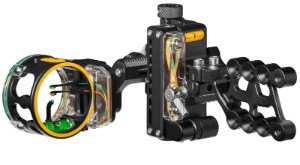
Keep Your Sights On Point
More important than having an opinion on which bow sight is better than another is knowing your own gear. Always train and practice with your equipment to become proficient with it.
If you know your system well, how it will perform at various distances, and you're intimate with its limits, you already know which one is best for you. Keep your sights on point and aim true!
Further Reading



